Cover
Table of Contents
Copyright
About the Author
Preface
1. Getting Started with the NextGen 3D Graphics API
Vulkan and its evolution
Vulkan versus OpenGL
Important jargons before we get started
Learning the fundamentals of Vulkan
Vulkan's execution model
Vulkan's queues
The object model
Object lifetime and command syntax
Error checking and validation
Understanding the Vulkan application
Driver
Application
WSI
SPIR-V
LunarG SDK
Getting started with the Vulkan programming model
Hardware initialization
Window presentation surfaces
Resource setup
Pipeline setup
Descriptor sets and descriptor pools
Shaders with SPIR-V
Pipeline management
Recording commands
Queue submission
Summary
2. Your First Vulkan Pseudo Program
Installing Vulkan
The Hello World!!! pseudocode
Initialization - a handshake with the device
Swapchain initialization - querying the WSI extension
Command buffer initialization - allocating command buffers
Resource objects - managing images and buffers
Creating a presentation surface - creating a swapchain
Creating a depth image
Resource allocation - allocating and binding device memory
Supplying shaders - shader compilation into SPIR-V
Building layouts - descriptor and pipeline layouts
Creating a Render Pass - defining a pass attribute
Framebuffer - connect drawing images to the Render Pass
Populating geometry - storing a vertex into GPU memory
Pipeline state management - creating pipelines
Defining states
Creating a graphics pipeline
Executing the Render Pass - drawing Hello World!!!
Acquiring the drawing surface
Preparing the Render Pass control structure
Render Pass execution
Queue submission and synchronization - sending jobs
Displaying with presentation layer - rendering a triangle
Fitting it all together
Summary
3. Shaking Hands with the Device
Getting started with the LunarG SDK
Setting up our first project with CMake
How to build the CMake file
Introduction to extensions
Querying layers and extensions
Creating a Vulkan instance
Enabling layers and extensions
Testing the enabled layers and extensions
Understanding physical and logical devices
Physical devices
Enumerating physical devices
Querying physical device extensions
Getting the properties of a physical device
Interrogating memory properties from the physical device
Logical device
Creating a logical device
Waiting on the host
Losing the device
Understanding queues and queue families
Querying queue families
Storing the graphics queue handle
Creating a queue
Implementing devices and queues all together
Summary
4. Debugging in Vulkan
Peeking into Vulkan debugging
Understanding LunarG validation layers and their features
Implementing debugging in Vulkan
Summary
5. Command Buffer and Memory Management in Vulkan
Getting started with command buffers
Explicit synchronization
Types of command in command buffers
Command buffers and queues
The order of execution
Understanding command pool and buffer APIs
Creating a command pool
Resetting a command pool
Destroying a command pool
Command buffer allocation
Resetting command buffers
Freeing command buffers
Recording command buffers
Queue submission
Queue waiting
Implementing the wrapper class for a command buffer
Implementing the command buffer allocation process
Recording the command buffer allocation process
How to use command buffer recording functions
Submitting the command to the queue
Managing memory in Vulkan
Host memory
Device memory
Allocating device memory
Freeing up device memory
Accessing device memory from the host
Lazily allocated memory
Summary
6. Allocating Image Resources and Building a Swapchain with WSI
Getting started with image resources
Image creation overview
Understanding image resources
Creating images
Destroying the created images
Understanding image layouts
Creating an image view
Destroying the image view
Memory allocation and binding image resources
Gathering memory allocation requirements
Allocating physical memory on the device
Binding the allocated memory to an image object
Introducing swapchains
Understanding the swapchain implementation flow
The swapchain implementation's class block diagram
Renderer - a window management custom class
Creating the presentation window
Initializing the renderer
Creating the command pool
Building swapchain and depth images
Rendering the presentation window
VulkanSwapChain - the swapchain manager
Querying swapchain extensions
Creating the surface with WSI and associating it with the created window
The graphics queue with present support
Querying swapchain image formats
Creating the swapchain
Swapchain surface capabilities and the presentation mode
Managing presentation mode information
Retrieving the swapchain's color images
Creating color image views
Creating a depth image
Introduction to tiling
Creating a depth buffer image object
Getting the depth image's memory requirements
Determining the type of memory
Allocating and binding physical memory to a depth image
Image layout transition
Image layout transition with memory barriers
Creating the image view
Summarizing the application flow
Initialization
Rendering - displaying the output window
Summary
7. Buffer Resource, Render Pass, Framebuffer, and Shaders with SPIR-V
Understanding the Vulkan buffer resource type
Creating the buffer resource object
Destroying the buffer
Creating a buffer view
Destroying the buffer view
Creating geometry with a buffer resource
Preparing geometry data
Creating a vertex buffer
Buffer creation overview
Implementing a buffer resource - creating the vertex buffer for the geometry
Understanding the code flow
Understanding a Render Pass
Attachments
Subpasses
Vulkan APIs for the Render Pass
Implementing the Render Pass
Using the Render Pass and creating the framebuffer
Implementing the framebuffer
Clearing the background color
Setting the background color in the Render Pass instance
Rendering the colored background
Working with a shader in Vulkan
Introduction to SPIR-V
Compiling a GLSL shader into SPIR-V
Offline compilation with the glslangValidator executable
Online compilation with SPIR-V tool libraries
Implementing a shader
Summary
8. Pipelines and Pipeline State Management
Getting started with pipelines
VulkanPipeline - the pipeline implementation class
Caching pipeline objects with a PCO
Creating a pipeline cache object
Merging pipeline caches
Retrieving data from pipeline caches
Implementing the PCO
Creating a graphics pipeline
Implementing a graphics pipeline
Destroying pipelines
Understanding compute pipelines
Pipeline State Objects (PSO) in Vulkan
Dynamic states
Implementing dynamic states
Vertex input states
Implementing vertex input states
Input assembly states
Implementing input assembly states
Primitive restart
Primitive topologies
Primitives topologies with no adjacency
Primitives topologies with adjacency
Rasterization
Rasterization states
Implementing rasterization states
Blending
Color blend states
Implementing color blend states
Viewport management
The viewport state
Implementing the viewport state
Depth and stencil tests
Depth and stencil states
Implementing depth stencil states
Multisample states
Implementing multisample states
Implementing the pipeline
Summary
9. Drawing Objects
Overview of the drawing process in Vulkan
Walking through the header declaration
Preparing the drawing object
Recording Render Pass commands
Beginning Render Pass instance recording
Transitioning to the next subpass
Finishing Render Pass instance recording
Implementation
Binding pipeline object
Implementation
Specifying drawing object geometry information
Implementation
Defining a dynamic viewport
Implementation
Scissoring
Implementation
Draw command
vkCmdDraw command
Implementing drawing object preparation
Rendering the drawing object
Acquiring the swapchain image
Executing the drawing command buffer object
Displaying the output with the presentation engine
Implementing drawing object rendering
Rendering an indexed geometry
Understanding synchronization primitives in Vulkan
Fences
Semaphores
Events
Resizing the display window
Summary
10. Descriptors and Push Constant
Understanding the concept of descriptors
VulkanDescriptor - a user-defined descriptor class
Descriptor set layout
Implementing the descriptor set layout
Destroying the descriptor set layout
Understanding pipeline layouts
Creating a pipeline layout
Implementing the pipeline layout creation
Destroying the pipeline layout
Implementing the pipeline layout destruction process
Descriptor pool
Creating a descriptor pool
Implementing the creation of the descriptor pool
Destroying the descriptor pool
Implementing the destruction of the descriptor pool
Creating the descriptor set resources
Creating the descriptor sets
Allocating the descriptor set object from the descriptor pool
Destroying the allocated descriptor set objects
Associating the resources with the descriptor sets
Implementing descriptor set creation
How to implement Uniforms in Vulkan?
Prerequisites
Execution model overview
Initialization
Shader implementation
Creating descriptors
Rendering
Binding the descriptor set
Update
Updating the transformation
Push constant updates
Defining the push constant resource in the shader
Updating the pipeline layout with the push constant
Updating the resource data
Summary
11. Drawing Textures
Image resource - a quick recap
Prerequisites for texture drawing
Specifying the texture coordinates
Updating the shader program
Loading the image files
Using the GLI library
Local image data structure
Implementing the image resource with linear tiling
Loading the image file
Creating the image object
Memory allocation and binding
Populating the allocated device memory
Creating the command buffer object
Setting the image layout
Submitting the command buffer
Creating an image sampler
Filtering
Wrapping modes
Creating the image view
Implementing the image resource with optimal tiling
Loading the image file
Buffer object memory allocation and binding
Populating the allocated device memory
Creating the image object
Image object memory allocation and binding
Creating a command buffer object
Setting the image layout
Buffer to image copy
Setting the optimal image layout
Submitting the command buffer
Creating an image sampler
Creating the image view
Copying data content between images and buffers
Updating the descriptor set
Summary
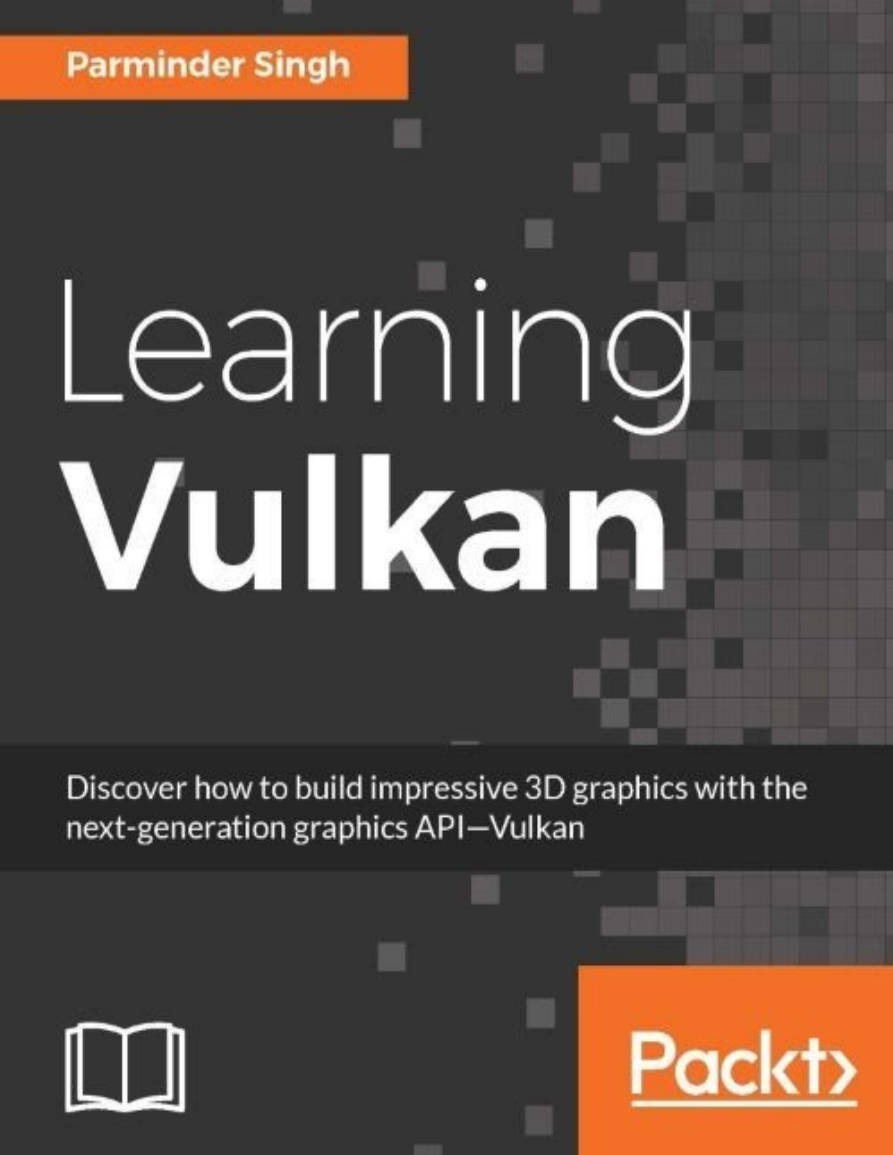
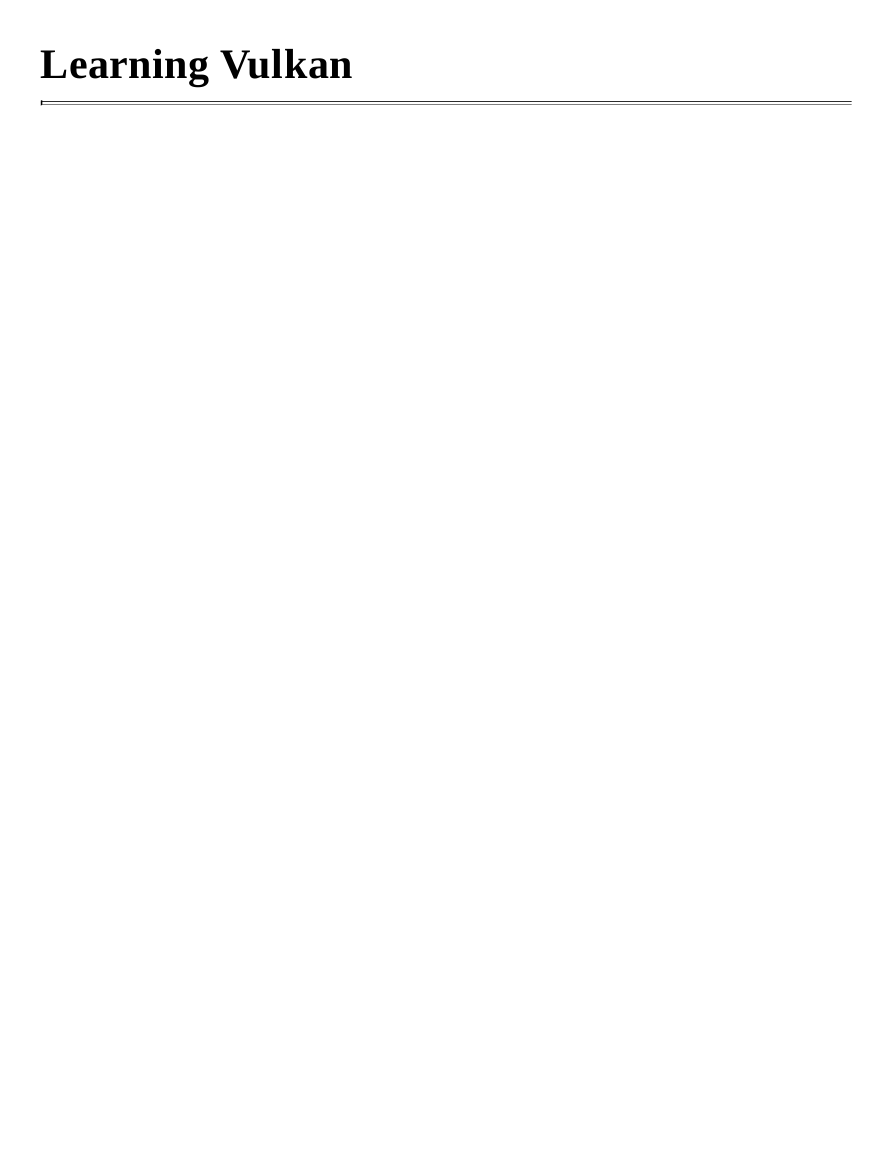

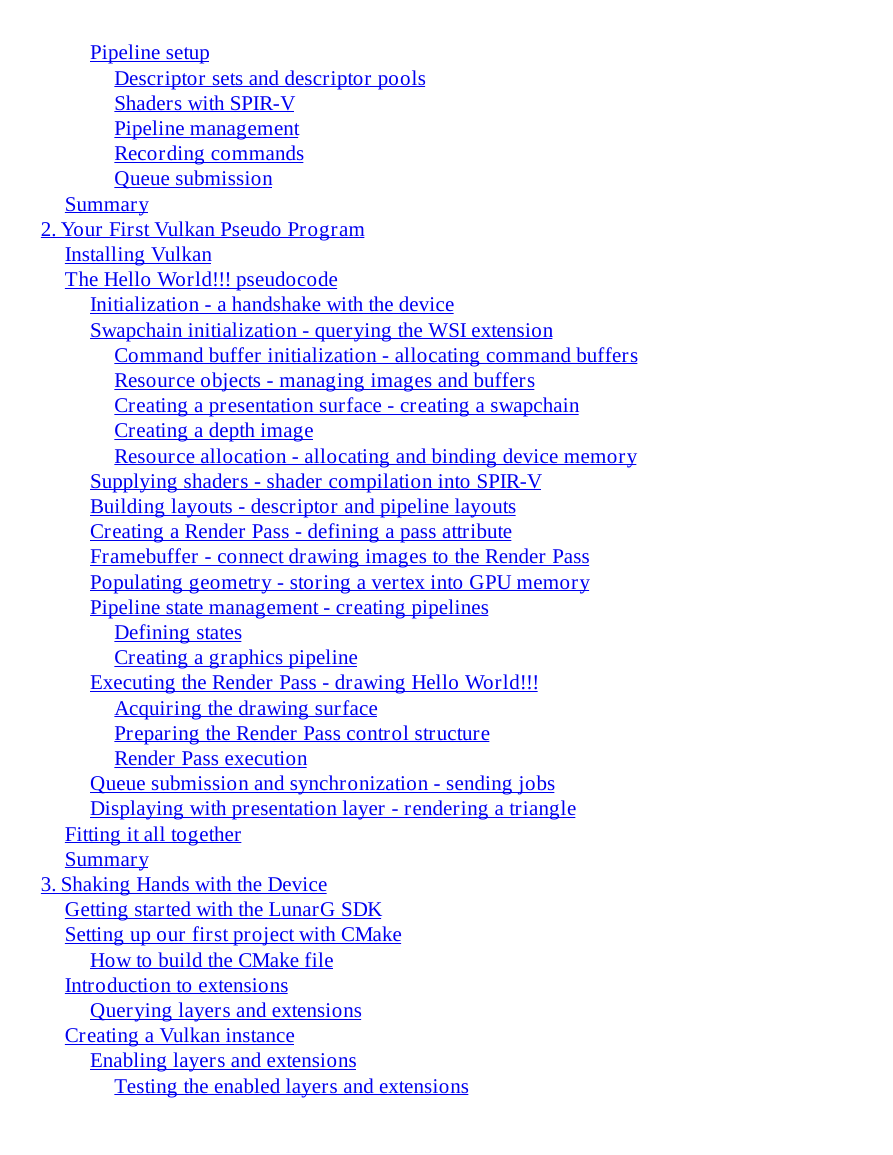
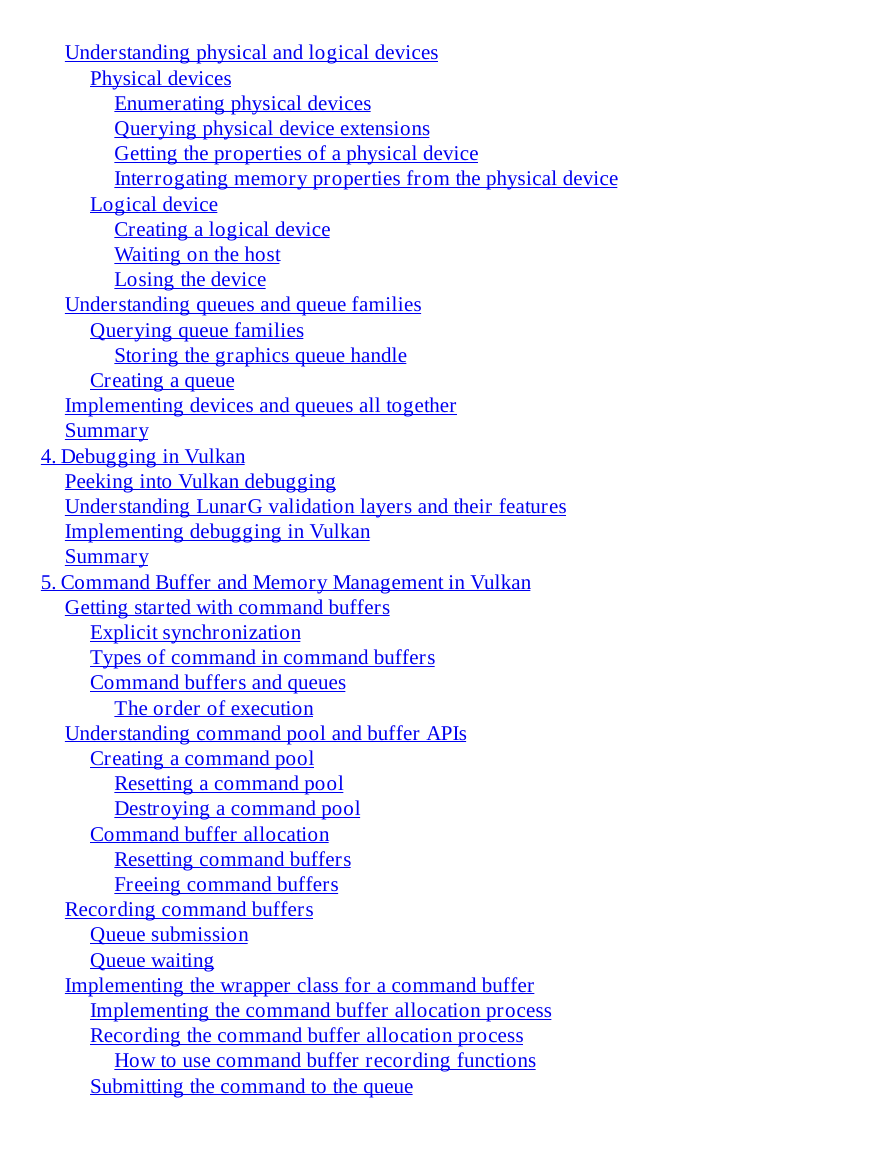


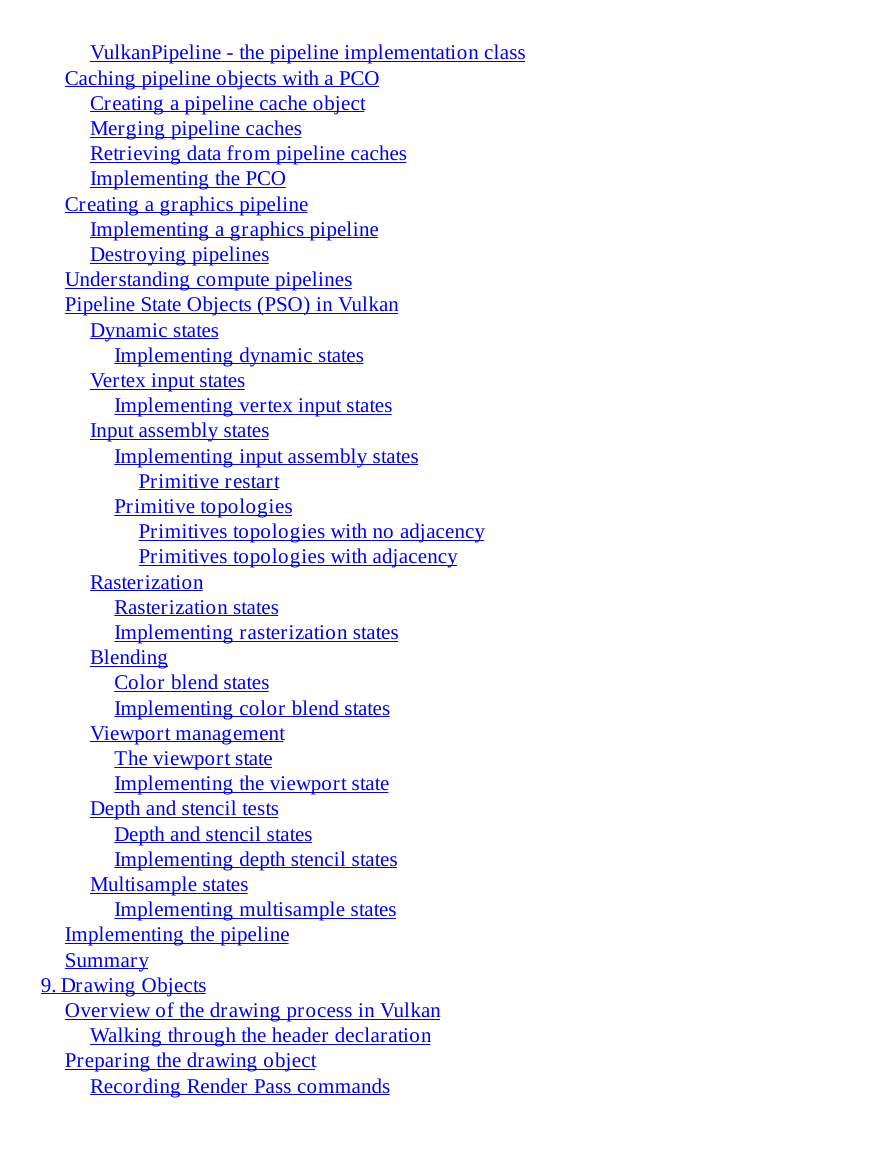








 2023年江西萍乡中考道德与法治真题及答案.doc
2023年江西萍乡中考道德与法治真题及答案.doc 2012年重庆南川中考生物真题及答案.doc
2012年重庆南川中考生物真题及答案.doc 2013年江西师范大学地理学综合及文艺理论基础考研真题.doc
2013年江西师范大学地理学综合及文艺理论基础考研真题.doc 2020年四川甘孜小升初语文真题及答案I卷.doc
2020年四川甘孜小升初语文真题及答案I卷.doc 2020年注册岩土工程师专业基础考试真题及答案.doc
2020年注册岩土工程师专业基础考试真题及答案.doc 2023-2024学年福建省厦门市九年级上学期数学月考试题及答案.doc
2023-2024学年福建省厦门市九年级上学期数学月考试题及答案.doc 2021-2022学年辽宁省沈阳市大东区九年级上学期语文期末试题及答案.doc
2021-2022学年辽宁省沈阳市大东区九年级上学期语文期末试题及答案.doc 2022-2023学年北京东城区初三第一学期物理期末试卷及答案.doc
2022-2023学年北京东城区初三第一学期物理期末试卷及答案.doc 2018上半年江西教师资格初中地理学科知识与教学能力真题及答案.doc
2018上半年江西教师资格初中地理学科知识与教学能力真题及答案.doc 2012年河北国家公务员申论考试真题及答案-省级.doc
2012年河北国家公务员申论考试真题及答案-省级.doc 2020-2021学年江苏省扬州市江都区邵樊片九年级上学期数学第一次质量检测试题及答案.doc
2020-2021学年江苏省扬州市江都区邵樊片九年级上学期数学第一次质量检测试题及答案.doc 2022下半年黑龙江教师资格证中学综合素质真题及答案.doc
2022下半年黑龙江教师资格证中学综合素质真题及答案.doc